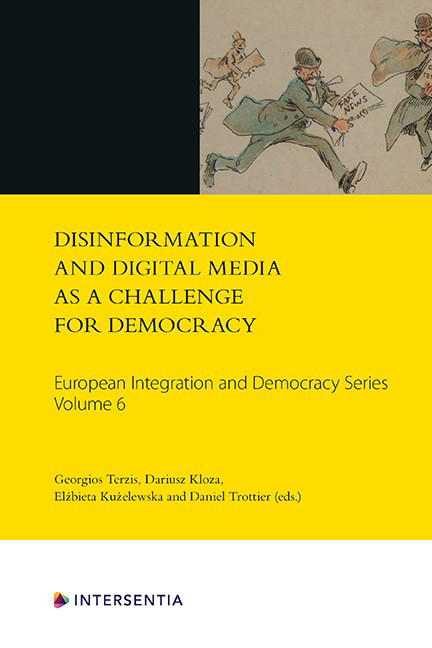Book contents
- Frontmatter
- Foreword: Fooling All of the People All of the Time: Democracy in the Age of Fake News
- Introduction: ‘They All Hear “Ping” at the Same Time’
- Contents
- List of Abbreviations
- List of Contributors
- PART I THEORETICAL APPROACHES TO AND THE CONCEPTUALISATION OF DISINFORMATION
- PART II EXPERIENCE OF DEALING WITH DISINFORMATION
- PART III SOLUTIONS TO DEAL WITH DISINFORMATION AND THEIR CRITIQUE
13 - Disinformation and Fake News in Current Jurisprudence of the Strasbourg Court: An Unsolved Problem
Published online by Cambridge University Press: 26 May 2021
- Frontmatter
- Foreword: Fooling All of the People All of the Time: Democracy in the Age of Fake News
- Introduction: ‘They All Hear “Ping” at the Same Time’
- Contents
- List of Abbreviations
- List of Contributors
- PART I THEORETICAL APPROACHES TO AND THE CONCEPTUALISATION OF DISINFORMATION
- PART II EXPERIENCE OF DEALING WITH DISINFORMATION
- PART III SOLUTIONS TO DEAL WITH DISINFORMATION AND THEIR CRITIQUE
Summary
INTRODUCTION
Numerous claims of fear or apprehensions have been expressed about the threats posed by the proliferation of disinformation and fake news within the current democratic society. Even though dissemination of misleading, untruthful or false stories has been recognised as an effective means to achieve various personal, political or other goals long before its online boom, it has to a great extent been the remarkable expansion of new technologies which brought to light a clear pressing social need to find more efficient tools to counter such practices. As a rich debate about appropriate ways of tackling the phenomenon of fake news takes place among scholars, within national governments and international organisations, our chapter aims to contribute to the debate by mapping the current approach of the European Court of Human Rights (hereinafter ‘ECtHR’ or ‘the Court’ ), a leading institution in forming current European human rights system by its substantive case law and legal interpretations.
Fighting false information through the court system represents only one of the multiple approaches to combating the dissemination of false information. Nevertheless, seeking protection through the courts remains one of the core mechanisms within the legal framework upon which the democratic society is built. Therefore, we believe that it is of great importance to address the topic from the perspective of judicial approach. It is only by means of detailed analysis of the existing case law that we are able to assess the effectiveness of judicial protection against false stories.
This chapter proceeds as follows. First, it briefly introduces the concept and definition of fake news as a starting point for the purpose of case law analysis (Section 2). Then it demonstrates the Court's approach towards the issue of disinformation through the inductive analysis of its existing case law (Section 3). Subsequently, it identifies key actors relevant to judicial proceedings and their roles within the process (Section 4). Finally, it assesses the overall effectivity of judicial means of tackling the proliferation of false information and suggests possible solutions (Section 5).
- Type
- Chapter
- Information
- Disinformation and Digital Media as a Challenge for Democracy , pp. 249 - 268Publisher: IntersentiaPrint publication year: 2020



